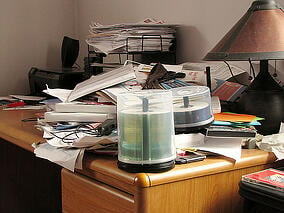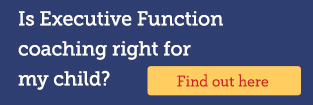Clutter, now that school is underway, has had a chance to take hold and start growing at a rapid rate. I’ve been a diligent clutter buster for years. In fact, my husband once bought me a magnet that reads “Organized People Are Too Lazy to Look for Things”, in a playfully teasing nod to my tidy ways. Many people are confused about or overwhelmed with how to get organized. If you are one of those people, this article is for you! Whether at home or working with clients, when it comes to school work and related items, I have discovered 4 easy steps for minimizing clutter and how to get and stay organized.
a diligent clutter buster for years. In fact, my husband once bought me a magnet that reads “Organized People Are Too Lazy to Look for Things”, in a playfully teasing nod to my tidy ways. Many people are confused about or overwhelmed with how to get organized. If you are one of those people, this article is for you! Whether at home or working with clients, when it comes to school work and related items, I have discovered 4 easy steps for minimizing clutter and how to get and stay organized.
1) Develop a system for organizing paper in your life
Have you heard of OHIO (Only Handle it Once)? When the mail comes in or when the papers from school arrive, make sure that they have a home and that you are not looking at them multiple times before you organize them . With so much information available electronically it may be more efficient to scan documents that are frequently used (such as health forms) into your smartphone or computer so that they are readily available. I have started to do this with any paper invitations or flyers as well. As soon as I scan them into my phone, I mark the date in my google calendar with a link to the info about the event. (For a list of scanning apps and what they do best, click here.)
Scanning papers to help get organized is also a great skill to model for teens. We often assume that because they are computer natives that they know what to do. I have often found that students who are disorganized with their belongings may also be disorganized with their desktop filing system. By modeling the use of folders, keeping an electronic calendar and knowing what to do with papers that need to be saved, we are helping our kids to create systems as well.
2) Create a specific spot for coats, shoes, sports equipment, and backpacks
When kids walk in the door, the tendency is to drop everything. First, as Sarah Ward recommends, create a “drop zone”, which is the place where the backpacks always go. I recommend an assigned coat hook and bin for each child. I found some attractive baskets and labeled one for each child. Not only do they know where to put their things when they get home, they know where to find them the next day and when company comes, the baskets can be stored out of sight.
For students with Executive Function issues, it can be difficult to visualize what goes in the basket, or what the backpack will look like when it is ready. If your child needs a visual cue, take a picture of the items that should go in the basket, laminate it and tie it on. The same can be done with the backpack or sports equipment bag. It can be more effective to use a picture rather than a checklist.
3) Establish a defined homework area
I recently asked a group of teens where they do their homework. While most kids are working at some type of table or desk, I was surprised by the number of teens that answered that they like to do their homework in bed! No matter where your child is doing homework (and we really recommend against doing school work in bed), there should be a place for general supplies such as paper (graph and lined), pens and pencils, stapler, memory sticks etc. I have used a portable file box exactly for this purpose. One of my students prefers to do her work at the dining room table. She keeps all of her textbooks and supplies in the portable file box which can be easily moved to other locations. At the end of the night, after packing her backpack, she puts all the books that can stay at home in the file box. If your child does not use a dedicated homework space, then it’s a good idea to use a strategy like this to help them efficiently locate supplies before they start working.
4) Set aside time to organize papers
For the disorganized child, the backpack can become a black hole where everything disappears. With most of the students that I coach, strategies for how to get organized, including how to organize their school materials, is a part of each session. One of my students reaches for his backpack and starts organizing all of the loose papers as soon as he sees me coming. Create a weekly time to go through the backpack with your child. Before you get started, have a 3 ring hole puncher, a trash bag and a recycling bag close by. Purchase a plastic file box for papers that no longer need to live in the binders. Keep in mind the FAT rule - File Action Toss. Ask your child is this a File, Action or Toss? If it is File, does it belong in the binder or in the appropriate file in their file box? If it is an Action item, what is the action that needs to be done? Write it on a sticky note and note it on a calendar or planner to make sure it gets done. If it is a Toss, first, make sure you really don’t need it, then recycle it.
While it is the rare teen that would enjoy spending their time organizing with a parent, you can use a timer (let’s just do this for 5 minutes) or a fancy latte as incentive (let’s just do this for 5 minutes and we can go to the coffee shop) or better yet, choose your favorite café and spend a half hour cleaning out the notebooks!
Follow these 4 steps for how to get organized and minimize clutter, and you’ll be amazed at how quickly you’ll find important items and papers when you need them. In other words, crush the clutter and gain peace of mind.
Does your child need help learning how to get organized or developing other self-management skills? Click below to find out how Executive Function coaching can help.
photo credit: Lisa Clarke

